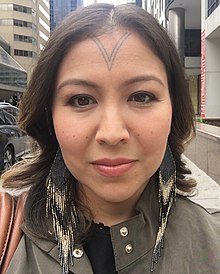Kakiniit
[1] Historically, the practice was done for aesthetic, medicinal purposes, part of the Inuit religion, and to ensure the individual access to the afterlife.
Despite persecution by Christian missionaries during the 20th century, the practice has seen a modern revival by organizations such as the Inuit Tattoo Revitalization Project.
[2][4] The terms are rendered in Inuktitut syllabics as ᑲᑭᓐᓃᑦ (Kakinniit), ᑲᑭᓐᓂᖅ (Kakinniq), and ᑐᓃᑦ (Tuniit).
[5] The Proto-Inuit word *tupə(nəq) 'tattoo' is the etymology of Eastern Canadian Inuktitut tunniq 'woman's facial tattoo'.
[9] Traditionally, the practice was done through sinew from caribou that was spun into a thread and was soaked in a combination of qulliq lampblack[9] and seal suet.
[14] Wearers of kakiniit in Inuit tradition would ensure that in the afterlife, the woman would be able to go to a place of happiness and good things.
[10] Traditionally a source of pride and a rite of passage for Inuit women, the practice was considered shamanistic to the Catholic missionaries and the communities that they worked to convert.
[9] The efforts of Anglican missionary Edmund Peck, who was fluent in Inuktitut, were particularly effective in extirpating Inuit cultural and religious practices, including kakiniit.
[4][17] Johnson started the organization when she found out that the practice was to die out with the last Inuk woman with facial tattoos.
[2] Inuk filmmaker Alethea Arnaquq-Baril's 2010 film, Tunniit: Retracing the Lines of Inuit Tattoos, documents the history behind the practice.
[2] Many Inuit figures bear traditional tattoos to showcase their embracing of their heritage, including: Celina Kalluk, Lucie Idlout, Angela Hovak Johnston, Laakkuluk Williamson Bathory, Nancy Mike, and Johnny Issaluk.
[9] Member of Parliament Mumilaaq Qaqqaq, who was elected in 2019 and representing the riding of Nunavut, wore traditional facial tattoos.


